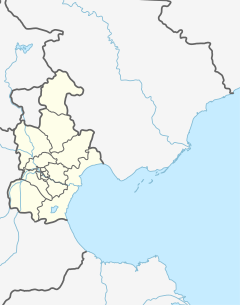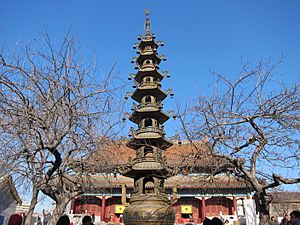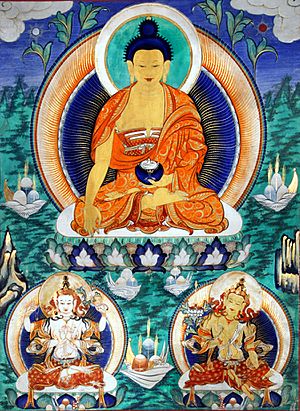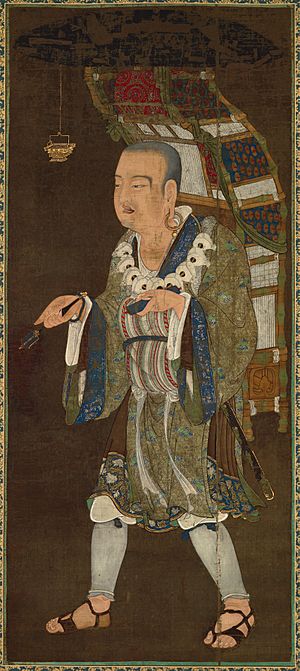Temple of Great Compassion facts for kids
Quick facts for kids Temple of Great Compassion |
|
|---|---|
|
大悲院
|
|
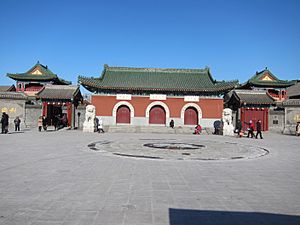
Temple of Great Compassion
|
|
| Religion | |
| Affiliation | Buddhism |
| Sect | Chan Buddhism |
| Location | |
| Location | Tianjin, China |
| Architecture | |
| Architectural style | Chinese architecture |
| Date established | 1644–1661 |
| Completed | 1875 (reconstruction) |
The Temple of Great Compassion, also known as Dabei Yuan (Chinese: 大悲院; pinyin: Dàbēi Yuàn), is a famous Buddhist temple located in Tianjin, China. It is a very old and important place for people who follow the Buddhist faith.
Contents
What is the Temple of Great Compassion?
This temple is one of the biggest and oldest Buddhist temples in Tianjin. It was first built a long, long time ago during the Qing dynasty (which was from 1644 to 1912). Over the years, it has been rebuilt and made new many times.
The temple is actually made up of two main parts:
- The West Monastery, which was built in 1669.
- The East Monastery, which was built much later in 1940.
Together, these two parts cover a huge area, about 10,600 square meters (that's like 114,000 square feet!). Inside the temple, you can also find the Tianjin Buddhist Institute, which is a school for studying Buddhism. This institute has many ancient statues that are very interesting to see.
Exploring the Old and New Parts
The old monastery is in the west part of the temple. It has three large halls. The building of this old section began at the start of the Qing dynasty. It was later fixed up and improved around the year 1669, during the time of the Kangxi Emperor.
The new monastery is in the east part of the temple. Here, you can find a very impressive statue of Sakyamuni Buddha. This statue was made during the Qing dynasty. It is huge, standing 7 meters (about 23 feet) tall and weighing 6 tons! What makes it even more special are the 9,999 tiny Buddhas carved into its lotus throne.
In another hall called the Great Compassion Hall, there is a large mud statue of the Thousand-hand Kwan-yin. This statue is 3.6 meters (about 12 feet) tall.
The Story of Xuanzang
The Temple of Great Compassion was once famous for holding a very special item: a skull relic of a famous Chinese monk named Xuanzang. Xuanzang lived a long time ago (he died in 664 AD) and was known for his amazing journey to India to bring back Buddhist scriptures.
In 1956, this special relic was given to India and taken to a place called Nalanda. It is now kept in the Patna museum. Because the relic is no longer at the temple, people at the Great Compassion Monastery now honor Xuanzang by using his image for worship instead of his actual relic.
In the east part of the temple, there are memorials for two important Buddhist monks: Xuanzang and Hong Yi. The west part of the temple is now used for offices, including the Cultural Relic Palace and the Chinese Buddhism Association Tianjin Branch. The Cultural Relic Palace in the west yard has many old items from different time periods in Chinese history. These include hundreds of Buddha statues made from various materials like bronze, iron, stone, and wood.
Cultural Importance of the Temple
The Temple of Great Compassion is very important for its cultural value. It is known for its beautiful mural art, which are paintings on the walls. The temple also plays a central role in the local culture of Tianjin, serving as a significant spiritual and historical landmark for the community.


